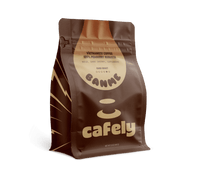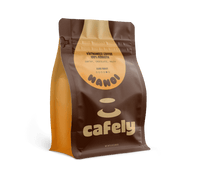A 12 oz can of Coca-Cola contains 34 mg of caffeine— which is on the lower side compared to other caffeinated beverages.
In this article, we’ll break down the amount of caffeine in the most popular Coke products and compare this popular soda brand to other caffeinated beverages.
The following charts give you a glimpse of what’s in each one, but we go into greater detail below.
Caffeine Content in Coca-Cola Products
|
Coca-Cola Product (12 oz) |
Caffeine Content |
|
Coca-Cola Classic |
34 mg |
|
Diet Coke |
46 mg |
|
Coke Zero |
34 mg |
Why Does Diet Coke Have More Caffeine Than Regular Coke?
Coca-Cola’s official website says Diet Coke has a more substantial amount of caffeine (46 mg per 12 oz) than regular Coke (34 mg per 12 oz). For many, a “diet” product shouldn’t be that different, aside from calories, than its counterpart.
However, a spokesperson from Coca-Cola explained why the diet version of the soda has more caffeine. Speaking to BeverageDaily.com, the Coke representative explained that the company adds more caffeine to the drink to give it a distinctly acidic, slightly more bitter flavor than the classic soda.
Coke vs. Other Caffeinated Drinks
Coke’s caffeine content is quite low compared to other popular caffeinated beverages.
Let’s take a look at how it compares:
|
Beverage |
Typical Drink Size |
Caffeine Content |
Caffeine Per oz |
|
Coke |
8 oz |
21 mg |
2.6 |
|
Green Tea |
8 oz |
35 mg |
4.4 |
|
Coffee (Arabica) |
8 oz |
95 mg |
11.9 |
|
Coffee (Robusta) |
8 oz |
150 mg |
18.8 |
|
Espresso |
1 oz |
77 mg |
9.6 |
|
Red Bull |
8.5 oz |
64 mg |
7.5 |
|
Monster Energy Drink |
8.5 oz |
86 mg |
10.1 |
|
Decaffeinated Coffee |
8 oz |
~6 mg |
0.75 |
Caffeine in Tea
There are thousands of different types of teas, with most falling into five main categories: green, black, white, oolong, and herbal. Each type has distinct flavors, benefits, and caffeine content.
Black tea has the strongest caffeine content, with an eight-ounce cup containing 40 to 60 mg of caffeine. Oolong and green teas usually have 30 to 50 mg of caffeine, while white tea is the weakest, at around 25 to 40 mg. While true teas have caffeine, their levels are generally much lower than those found in coffee.
Herbal teas are mostly caffeine-free. You can also find decaffeinated versions of most teas, but like decaffeinated coffee, they still have trace amounts of caffeine.
Caffeine in Coffee
Coffee has different beans and brewing methods that affect the caffeine content. Drip coffee, the most common brewing method in the US, has around 90 mg of caffeine in a standard cup.
The strongest concentration of coffee is a shot of espresso with 77 mg per ounce. Because espresso is made from finely ground coffee beans, the caffeine content is much higher. However, the portions are usually smaller, so you end up with less caffeine than a cup of coffee.
Vietnamese coffee also has a high caffeine content because of the coffee beans and the method used to brew it. The beverage is made with a phin drip filter, which is a bit like a mix between espresso and pour over. On top of this, the robusta beans used to brew traditional Vietnamese coffee have almost twice as much caffeine as arabica beans.
Related: What Makes Vietnamese Coffee So Strong?
Caffeine in Energy Drinks
Popular energy drinks like Monster Energy and Red Bull also have much more caffeine than Coca-Cola. Red Bull, one of the most popular energy drinks in the US, has 64 mg of caffeine in an 8.5 oz can, almost twice as much as a 12 oz can of Coke. Like sodas, many energy drinks add synthetic caffeine to their mixtures.
How Much Caffeine is Too Much?
Caffeine has its perks, but there are negative side effects to consider before popping open your 12th can of Coke in a day. Studies show that you should limit your daily consumption of caffeine to around 400 mg. That’s just over 11 cans of Coke or four cups of coffee.
However, since every person’s body reacts to caffeine differently, you may be able to handle more or less caffeine in a day. Keep a lookout for some common negative side effects of too much caffeine [1]. If it's a common occurrence, you may want to cut back your caffeine intake.
Here’s a list of potential side effects to look out for:
- Difficulty sleeping
- Jitters
- Irritability
- Increased heart rate
- Nervousness
- High blood pressure
- Gastrointestinal issues
- Headaches
- Psychomotor agitation
Maybe you’ve noticed caffeine doesn’t affect you like it used to. This means you’ve developed a tolerance to it and should cut back. Your body will adjust, and you’ll be able to feel the effects again. It’s not a good idea to increase the caffeine so you can feel it.
You may have to go through caffeine withdrawal, but your body will thank you.
Best Caffeine-Free Alternatives
Many people love the taste of sodas but can’t consume caffeine for dietary, religious, or other personal reasons. In fact, avoiding coffee in some religions is a common practice, leading individuals to seek caffeine-free options that align with their beliefs. Luckily, there are many options that can satisfy your sweet and bubbly cravings.
Caffeine Free Coke
Coca-Cola used to contain caffeine naturally because of the kola nut extra used in the original recipe. However, now the soda giant uses coca plant extracts in its drinks.
The good news is this extract can easily be left out without majorly affecting the taste, so the caffeine-free versions taste about the same.
Decaf Coffee
Yes, decaffeinated coffee does have a low amount of caffeine — somewhere between zero and 0.9 mg per ounce. Yes, there's still a bit of caffeine left after decaffeination, but the amount is extremely low, especially compared to a cup of regular coffee.
Ginger Ale
Ginger ale was originally used to help alleviate nausea — the drink’s traditional recipe included fermented ginger, sugar, and water. Though most of the more common ginger ales on the market today are made with synthetic flavors, there are plenty you can find that use ginger extract.
Carbonated Water
Carbonated waters are generally caffeine-free and have plenty of interesting flavor options. Seltzer water is the most basic, which is simply plain water with carbonation. Tonic, on the other hand, has added sugar and minerals to give it a unique, zesty flavor.
Root Beer
Root Beer is another flavorful, caffeine-free option. The dark soda was traditionally flavored with sassafrass tree root, giving it a unique earthy flavor with added notes of vanilla, caramel, cinnamon, and molasses.
Most root beers nowadays are artificially flavored and caffeine-free, but some popular brands, like Barq’s, do have caffeine. Be sure to check the label before drinking.
Other Caffeine-Free Sodas
There are too many caffeine-free sodas out there to list, so how can you tell if a drink you find has caffeine? Fortunately, all sodas are required to tell you if the beverage contains added caffeine, but not if the drink has naturally occurring caffeine [2]. On top of this, companies aren’t required to state on the label how much caffeine a drink has.
Check the label for the phrase “Contains Caffeine.” Usually, brands post this around the nutritional facts. If the label states “caffeine-free,” then you can safely assume the drink doesn’t contain caffeine.
How Does Caffeine Affect the Flavor of Coke?
It may not be too surprising to learn that caffeine actually does have a flavor. If you think of caffeinated beverages like coffee or espresso, the first flavor that comes to mind might be bitterness.
The real surprise, though, is that when given a caffeine-free and a caffeinated soda, people can’t tell the difference. According to a study by Johns Hopkins Medical Institutions, only eight percent of participants can tell if a soda has caffeine.
FAQs: Caffeine & Coca-Cola
Still have questions about caffeine in Coke? We have answers to the most common below.
1. How much caffeine is in a can of regular Coke?
A 12-ounce can of Coke has 34 mg of caffeine. Glass Coke bottles typically contain 8 ounces, which works out to around 21 mg of caffeine.
2. Is there more caffeine in Diet Coke than regular Coke?
Yes, Diet Coke contains 46 mg per 12 oz, which is more than regular Coke. The company claims they’ve added more caffeine to Diet Coke’s formula to maintain its distinct acidic, slightly more bitter flavor than the classic version.
Coke Zero only contains 34 mg of caffeine.
3. How does the caffeine content in Coke compare to coffee?
A 12 oz serving of Coke has 34 mg, almost one-third less caffeine than a cup of coffee (8 oz), which has 95 mg of caffeine.
4. What are the effects of caffeine consumption?
Caffeine consumption has plenty of effects, both positive and negative. Some positives include increased alertness and focus. However, if you consume too much caffeine, that can lead to potential side effects like insomnia, jitters, irritability, anxiety, and increased heart rate.
5. Are there caffeine-free versions of Coca-Cola available?
Yes, Coca-Cola offers caffeine-free versions of their popular sodas.
6. Can children consume Coca-Cola due to its caffeine content?
Coca-Cola is safe for children because it has a lower caffeine level than coffee or energy drinks. However, children will suffer the same negative effects if they consume too much caffeine.
Researchers analyzed a series of studies examining caffeine consumption and its effects on children [3]. They found that caffeine reduces children’s total sleeping time and increases depressive symptoms and anxiety.
7. What are some popular caffeine-free soft drinks?
There are many caffeine-free soft drink options, including:
- Caffeine-free Coke
- Seltzer Water
- Lemon-Lime sodas
- Root Beer
- Ginger Ale
8. How does caffeine affect the body?
There are both positive and negative effects on the body when you consume caffeine. The main positive of caffeine is that it increases alertness. However, caffeine may also cause jitteriness and changes in sleep patterns, especially if you have too much.
References
- Wierzejska, R. (2012). Caffeine: A common ingredient in diet and its influence on human health. Roczniki Panstwowego Zakladu Higieny, 63(2), 141-147.
- Kole, J., & Barnhill, A. (2013). Caffeine content labeling: a missed opportunity for promoting personal and public health. Journal of caffeine research, 3(3), 108-113.
- Torres-Ugalde, Y. C., Romero-Palencia, A., Román-Gutiérrez, A. D., Ojeda-Ramírez, D., & Guzmán-Saldaña, R. M. (2020). Caffeine consumption in children: Innocuous or deleterious? A systematic review. International journal of environmental research and public health, 17(7), 2489.











![How Much Caffeine Is In Mountain Dew? [Answered]](http://cafely.com/cdn/shop/articles/how_much_caffeine_in_mountain_dew_128d91bf-4b15-4d85-8e5a-b153f36b279b.jpg?v=1743546639&width=400)




